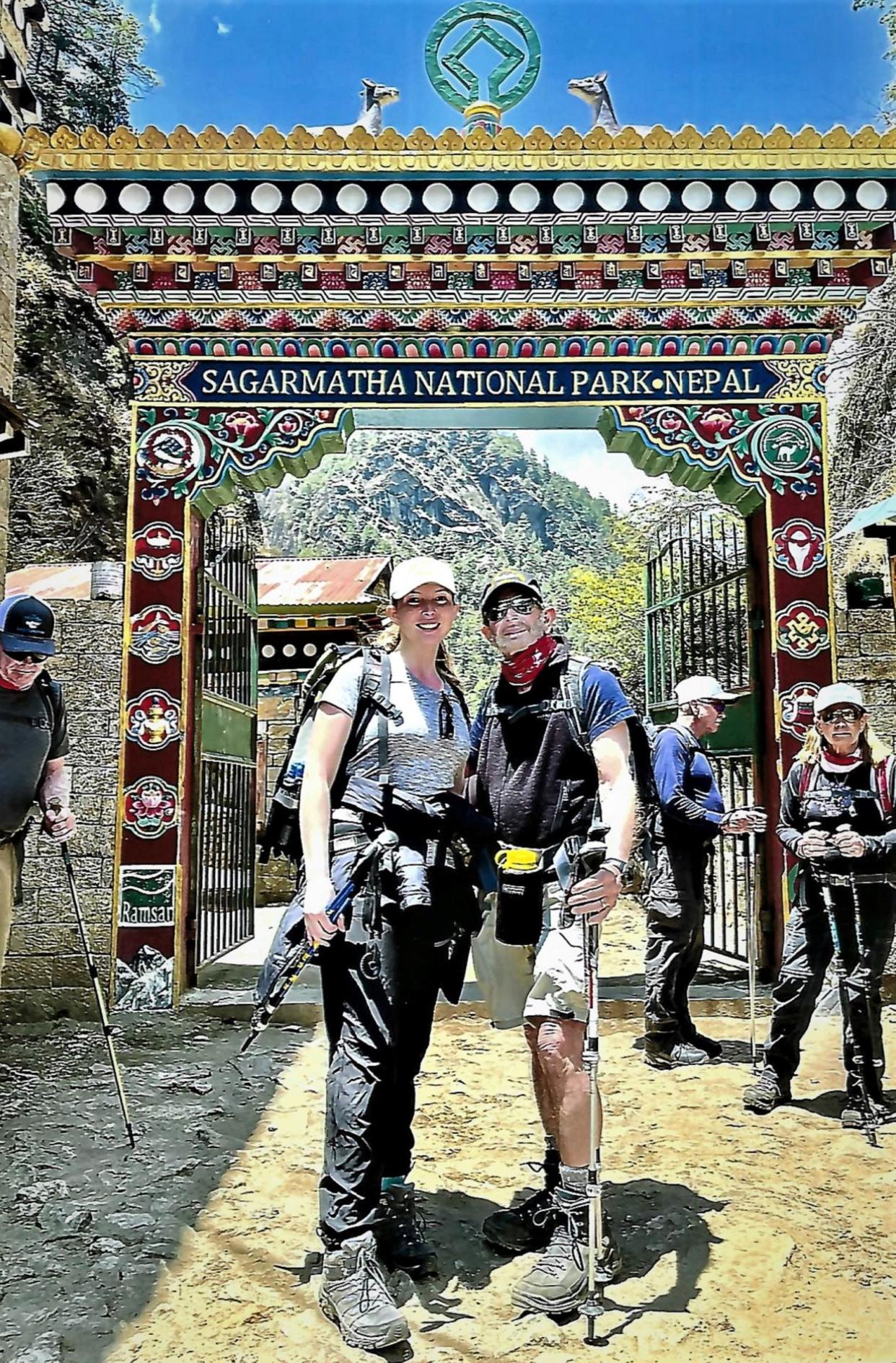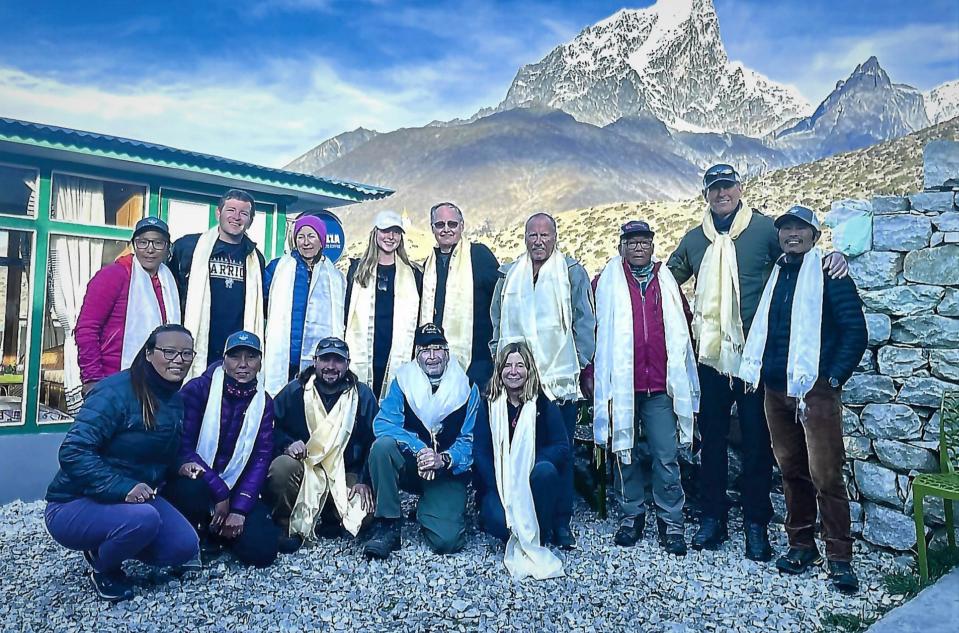Mark Woods: At nearly 80, climbing Everest and outliving family history

When I grow up, I’d like to be like Jerry Maida.
And by that I don’t mean I hope to be such a good student that I’ll be accepted to medical school before I even graduate from college, go to Tanzania for a medical mission, serve in the Navy as a flight surgeon, start a practice in Jacksonville, take a gamble on some new technology and end up as one of the pioneers of LASIK in America.
It’s too late for that.
And while I’m certainly impressed by what Dr. Maida did in his first 60 years, the reason we ended up having a long conversation recently had more to do with what he didn’t do until his late 50s and all that he has done since. Not that I presume to match those accomplishments, either. But I have been thinking about them — and more broadly the topic of longevity.
Maida, who will turn 80 in November, recently returned from his eighth trek into Mt. Everest area.

This time his group — “Maida Mountaineers,” as they call themselves — included his oldest grandchild, Ella Porter.
“I felt like it was a tough hike for me at 24 years old, so I couldn’t imagine doing it at 79,” she said after returning to New York.
Maida emphasizes that he didn’t summit the highest peak in the world. He doesn’t want anyone to get that impression. But what he did — what he has done in the last 25 years — is fairly remarkable. The company that led his latest multi-week trek said he might be one of the oldest to do it.
Whether or not there’s any record there really is beside the point.
With about 10,000 Baby Boomers turning 65 every day, aging and longevity has become a particularly hot topic. We have ABC airing “The Golden Bachelor,” Blue Zones attempting to replicate the keys to the longest-lived people in the world, and the book “Outlive: The Science and Art of Longevity” sitting near the top of the New York Times bestsellers list for 26 weeks and counting.
“Outlive” was written by Peter Attia, a 50-year-old doctor who has built his career around improving “healthspan” — the idea of not just living longer, living better longer.
Maida mentioned the book to me before we talked. He had read it. In some ways, he has been living it.
Driven to succeed
Born and raised in Brooklyn, one of Maidi’s friends in the neighborhood was Anthony Fauci. Fauci’s father was his godfather. And Maida says they had something else in common.
“The reason we became successful is that we never went out,” he said. “If we went out, we got beat up by the guys who had clubs and knives. So we stayed in and studied and studied and studied.”
His parents had high expectations. He recalls them telling the story of how when they got married, they had $9 to their name and lived in a one-room apartment for eight years. They expected their children to be self-motivated, driven to determine whether they succeeded or failed. And they didn’t tell them either was certain. When Maida came home from med school with one bad grade, his mother said, “I didn’t think you could do it anyway.”
“Maybe that’s just the way parents were 60 years ago,” he said. “There wasn’t patting on the back.”
His father always told him that it didn’t matter what he decided to do. Just be the best. If you’re a shoemaker, that’s fine. Just be the best shoemaker.
When he decided to be an ophthalmologist, he strived to be the best ophthalmologist he could be. He says he was a workaholic. And all that work certainly led to success. He lives in a beautiful home at the beach with his wife of nearly 40 years, Sandy, and their dog, Coco.
They have five children. And one of their many bookshelves contains photo albums full of reminders of some of the many places they’ve gone together, quite a few of the trips later in life.
So the moral to the story is that hard work is the key to living a good life after 65?
Not exactly.
Seeing his future
Go back to early 1989. Maida was in Berlin and learned about the refractive surgery a German doctor was doing.
He told his wife, “I’ve just seen the most amazing thing in the world. I saw a procedure where someone with glasses got rid of them. … This is what I’m going to do the rest of my life.”
She asked him if insurance would cover it. No, he said. It wasn’t even an approved procedure in the United States. But even before it was, he invested $300,000 in a laser and went overseas — to have the procedure on his own eyes and to train to do it himself.
June 3, 1989. He remembers this date because it’s when he did the procedure for the first time.
For years, he basically did two jobs. His cataract practice in Jacksonville a few days a week, his PRK and then LASIK practices in Colombia, Peru and Ecuador. As if that wasn’t enough, in the 1990s, he also got his MBA from Wharton.
In 1999, LASIK surgery was approved in the United States. And while that certainly was a significant moment — Maida eventually sold his cataract practice and devoted all of his work to LASIK — there was perhaps an even more life-changing one for him that year.
A trip to Everest
He recalls that about a year earlier the chief of the leadership department at Wharton had called him, asking if he wanted to go on a hike.
“Where?” he asked.
“Everest.”
“Absolutely not,” he said. “I haven’t exercised a day in my life.”
But he also had some powerful incentive to start. He and Sandy had gone on a vacation that was quite different from an Everest trek, a spa in the desert in Arizona. While there, they’d had some tests done. His bloodwork showed he was at high risk of cardiac arrest and a fate like his father, who died at 53, and uncle, who died at 48.
The doctor said he had a choice. He could change his lifestyle. Or he could follow in his family’s footsteps.
So he started training for Everest and ended up heading there with a group of about 15 people. The hiking was daunting, the conditions primitive, the food bad ....
“It was horrible, so difficult, much worse than I imagined,” he said.
When he returned home, Sandy barely recognized him. He'd lost 25 pounds. And he had such back pain that he ended up in bed for about a week. When he went to a top neurosurgeon in Gainesville, the doctor told him that it wasn’t something that happened on the hike. He had such extreme degeneration that he could be in a wheelchair within a year.
“Hearing that affected me,” he said, “probably more than anything in my life.”
He didn’t have surgery. But he did begin doing yoga every morning, something he continues to do religiously. Today his back is better than it was years ago. And he also began to think about wanting another shot at Everest. He hadn’t forgotten how hard it was. That was part of the appeal. The challenge, the beauty, the people, the camaraderie.
He made the training — using a stair climber in flat Florida — part of his daily life here and kept heading to mountains around the world.
'Life lessons, family and goals'
In 2004, after Sandy had breast cancer, he’d heard there were a couple of climbers who were raising money for breast cancer. He had a fundraiser at their house that included breast cancer advocate and future mayor Donna Deegan. And when he planned a climbing trip to the Grand Tetons — led by a guide who’d developed breast cancer, along with a couple other women facing personal battles — NBC made it part of a Jane Pauley show.
He has been back to the Tetons several times. He has done repeated trips down into the Grand Canyon, taking family and staff on hikes.
He climbed to the top of Mt. Kilimanjaro, at 19,341 feet above sea level the tallest mountain in Africa. He’s climbed parts of Denali (America’s tallest mountain in Alaska) and Mont Blanc (highest mountain the Alps). But more than anything, he has been drawn to return to the Himalwayas and Everest.
In his mid-60s, he thought he might be done. And not necessarily because he was getting older. After he lost a friend there, he said he wasn’t going back.
But then he was asked by the wife of a patient, Glenn Allen — who had always wanted to go to Everest but had died of leukemia at age 57 — if he’d scatter some of her husband’s ashes there. Once he agreed, his sister asked him to also scatter some of the ashes of her husband, Jan Michaelson, a nurse who had died of cancer.
He fulfilled their wishes at Chukhung Re II, a peak of about 19,000 feet — the Everest summit is above 29,000 feet — that is considered sacred by Buddhists.
It was, he said, an overwhelming spiritual experience.
Even after that, though, he thought he was nearing the end of his Everest days. When he hit 60, he’d already outlived the men in his family who came before him. When he hit 70, he’d say he wanted to stay active until 80. Now he’s nearly there, still planning trips for the Maida Mountaineers.
“It’s important to pick the right people — people who are going to be there for you no matter what,” he said. “It’s a very interesting group. We have some Republicans and some Democrats, but we all get along so well.”
He has slowed down. And it is more challenging to stay healthy, not just during the trips but while preparing for them. But when he’s hiking, he keeps moving, surprising others by the miles he covers.
“He’s an interesting hiker,” Sandy said. “Everybody else on a trip will take off, wanting to get there fast. He’s the steady Eddy. It’s like the tortoise and the hare.”
While she loves travel and nature, she also likes to finish the day at a place with a shower and decent toilets. So this is his thing. He has taken his two sons. And he had dreamed of doing it long enough that he could take a grandchild. So this last trip, with a 24-year-old granddaughter, was particularly memorable — for both of them.
“On the hike, we spent hours and hours just talking about life — life lessons, family and goals,” Ella Porter said. “At the end of the hike, my grandpa said, ‘I came here with my granddaughter and left with a new best friend.’”
He stopped doing surgery a few years ago, after about 38,000 surgeries.
“My hand is still phenomenal,” he said, holding out his hand to show the steadiness. “But you have to stop sometime.”
He still goes into the office to see patients — beyond helping them improve their vision, he says he wishes he could help people see what he has seen and “focus on health and longevity” — and he hasn’t stopped thinking about the next mountain.
Before the latest trip to Nepal, he talked about how this probably was his Everest trek. Not long after returning home, he began talking about maybe doing another one.
mwoods@jacksonville.com, (904) 359-4212
This article originally appeared on Florida Times-Union: Jacksonville LASIK pioneer outlives family history, climbs Everest

